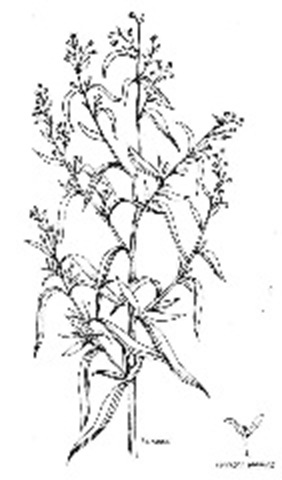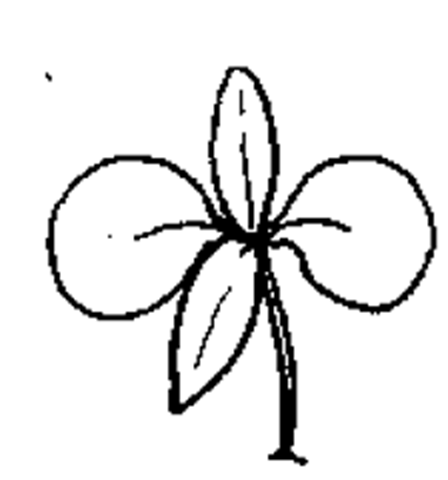Common name: tarragon Botanical name: Artemisia
dracunulus Origin: Caspian Sea, Siberia
Varieties
Few varieties are available. Grow the variety available in your area, but try to make sure that it’s the French, not the Russian, kind.
Description
Tarragon is a half-hardy perennial that grows two to four feet tall; it has slender stems and thin narrow leaves that taste a bit like licorice, and it rarely produces flowers—they’re small and whitish in color. True French tarragon is a sterile clove and cannot be grown from seed; use rooted divisions or stem cuttings. There is also a Russian variety of tarragon, which has a stronger flavor that most people don’t like. Many herbs are decorative, but tarragon is not glamorous. However, its finely textured dark-green foliage makes an attractive background for small, bright flowers. The word tarragon comes from the Arabic word for dragon. The French translation, estragon (little dragon), might reflect either the way tarragon was used medicinally to fight pestilence during the Middle Ages, or the snakelike appearance of its roots.
Where and when to grow
Tarragon can be grown anywhere in the United States and will survive cold winters if it’s given adequate protection. It’s hardy in well-drained, sandy soils, but is less tolerant of cold in compacted or wet soil.
How to plant
Seeds of the Russian variety are available commercially, but are likely to produce plants of inferior flavor. Instead, use divisions or stem cuttings of French tarragon. Tarragon tolerates poor, rather dry soil. Fertilize the soil the first year only with a low-nitrogen (5-10-10) fertilizer; before planting, work the fertilizer well into the soil at the rate of a half pound to 100 square feet. Plant cuttings or divisions on your area’s average date of last frost, and set them 18 to 24 inches apart in rows 24 to 36 inches apart. Give them a place in full sun; the plant will tolerate partial shade, but the flavor will be impaired.
Fertilizing and watering
Don’t fertilize at midseason. Detailed information on fertilizing is given in “Spadework: The Essential Soil” in Parti.
Keep tarragon on the dry side to encourage the flavor to develop.
Special handling
If you live in an area where the ground freezes and thaws often in the winter, mulch after the first freeze so that a thaw will not push the plant up and out of the ground. Mulching also helps the tarragon survive the cold. Subdivide the plants every three or four years.
Pests
Tarragon has no serious pest problems. It does well in the organic garden.
Diseases
Tarragon has no serious disease problems.
When and how to harvest
Time from planting to harvest is about 60 days, and you don’t need a lot of tarragon. One plant supplies the average family, so if you’re growing a lot you will be able to supply the whole neighborhood. Pick the tender top leaves of tarragon as you need them. Cut back the leafy top growth several times during the season to encourage the plant to bush out.

the one grown for flavoring. The Greeks and Romans believed that thyme gave courage and strength; their highest compliment was to tell a man that he smelled of thyme. In the Middle Ages ladies embroidered sprigs of thyme on the scarves they gave their knights. Linnaeus, the father of modern botany, recommended thyme as a hangover cure.
Where and when to grow
Thyme prefers a mild climate but can survive temperatures below freezing. It tolerates cold better in well-drained soil. Plant thyme from seed anywhere in the United States two to three weeks before your average date of last frost.
How to plant
Thyme likes well-drained soil, preferably low in fertility; rich soils produce plants that are large but less fragrant. The first year, work a low-nitrogen (5-10-10) fertilizer into the soil before planting at the rate of about a half pound per 100 square feet. This is generous of you, because in adverse soil conditions thyme, like many herbs, will have better flavor. Whatever the soil’s like, it’s important to give thyme a place in the sun. Plant seeds in early spring, two to three weeks before your average date of last

Thyme seedling
frost. Plant the seeds a quarter inch deep in rows 16 to 24 inches apart, and when the seedlings are two to three inches tall thin them about a foot apart. You can also plant thyme cuttings or root divisions. Plant them at the same time, and space them a foot apart.
Fertilizing and watering
Don’t fertilize at midseason. Detailed information on fertilizing is given in “Spadework: The Essential Soil” in Parti.
Thyme seldom needs watering; it does best on the dry side.
Special handling
Some herbs, like mints, grow like weeds whatever the competition. Thyme can’t handle competition, especially from grassy weeds, and needs an orderly environment; cultivate conscientiously.
Start new plants every three to four years, because thyme gets
woody; reduce the clump greatly. If you’ve no room in the garden for extra plants, plant them in a hanging basket.
Pests
Thyme has no serious pest problems. Like most herbs, it’s ideal for the organic gardener.
Diseases
Thyme has no serious disease problems.
When and how to harvest
Pick thyme as needed. For drying, harvest when the plants begin to bloom. Cut off the tops of the branches with four to five inches of flowering stems.
Storing and preserving
After drying, crumble the thyme and put into tightly capped jars. Detailed information on storing and preserving is given in Part 3.
Serving suggestions
Thyme is usually blended with other herbs and used in meat dishes, poultry, stuffings (parsley and thyme is a happy combination), and soups. It adds a nice flavor to clam chowder and is often used along with a bay leaf to give a delicate lift to a white sauce or a cheese souffle.
storing and preserving
Tarragon is best fresh, but can be dried or frozen. Detailed information on storing and preserving is given in Part 3.
Serving suggestions
Put a fresh stem or two of tarragon into bottles of good cider vinegar or wine vinegar and, vo/7a, tarragon vinegar; allow a couple of weeks for the flavor to develop before you use it. Since the flavor of tarragon is so distinctive, use it with a light touch. Use the leaves to decorate cold dishes glazed with aspic. It’s tarragon that gives a kick to a good sauce tartare, and, of course, you can’t have chicken tarragon without it.
